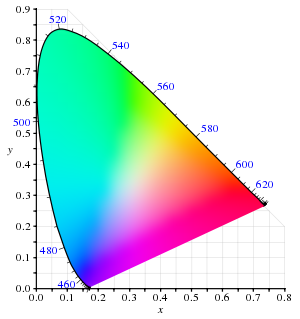Photoredox catalysis
Academy Color Encoding System (ACES) is a color image encoding system proposed by the Academy of Motion Picture Arts and Sciences that will allow for a fully encompassing color accurate workflow, with "seamless interchange of high quality motion picture images regardless of source".[1]
The system has defined its own color primaries that completely encompass the visible spectral locus as defined by the CIE xyY specification. The white point is approximate to the CIE D60 standard illuminant, and ACES compliant files are encoded in 16-bit half-floats, which are valid in the range -65504.0 to +65504.0.[1]
The system has not yet been fully developed, but is currently in active research and in the works to be fully supported by the Society of Motion Picture and Television Engineers (SMPTE) standards body. As such, all information within this article is subject to change and may not accurately reflect the current ACES specifications.
Background
The ACES project began its development in 2004 in collaboration with 50 industry technologists.[2] The project began due to the recent incursion of digital technologies into the motion picture industry. The traditional motion picture workflow is based on the foundation of film capture, this is however increasingly not the case, images are coming from a variety of both digital and film sources. The ACES system is an effort to control the complexity inherent in managing a multitude of file formats, image encoding, metadata transfer, color reproduction, and image interchanges that are present in the current motion picture workflow.
System Overview
Template:Prose Template:Condense The system composes of several components all of which are designed to work together to create a uniform workflow.
Input Device Transform (IDT)
- The process that takes the content from any ingestible source material and transforms or optimizes the content for the ACES color space and encoding specifications. There will be many IDT’s, which will be specific to each capture device and likely specified by the manufacture under the ACES guidelines.
Academy Color Encoding Specification (ACES)
- The specification that defines the ACES colorspace, and high-precision encoding. The defined colorimetry is scene-referred and appearance-correlated.
Reference Rendering Transform (RRT)
- Converts the scene-referred colorimetry to display-referred, and is based on legacy film image rendering though it has a larger gamut and dynamic range available to allow for rendering to any output device (even ones not yet in existence).
Output Device Transform (ODT)
- A guideline for rendering the large gamut and wide dynamic range of the RRT to a physically realized output device with limited gamut and dynamic range. There will be many ODT’s, which will be likely generated by the manufactures to the ACES guidelines.
Academy Printing Density (APD)
- A reference printing density defined by the AMPAS
Academy Density Exchange (ADX)
- A encoding wrapper specified by the AMPAS
Color Space[3]

The ACES color system has defined its own color primaries that lay outside of the visible spectrum and contain the entire spectral locus. The concept of using non-realizable or imaginary primaries is not new, and is often employed with color systems that wish to render a larger portion of the visible spectral locus. The ProPhoto RGB color space developed by Kodak is such system.
ACES uses the primaries RGB for the purpose of familiarity in the cinema community, where each primary when varied will respond as expected in a typical RGB additive color system such as sRGB. This is unlike CIE XYZ or CIE xyY where the values do not directly corresponded to an additive primary system, which results in hue shifts if the values are adjusted individually, such as by a colorist. For this reason, CIE XYZ or xyY values are used in purely mathematical spaces and are not representative of human color perception.
The ACES RGB primaries completely encompass the CIE spectral locus and are representative of scene colors captured by a real or virtual device. Values outside the spectral locus are maintained with the assumption that they will later be manipulated through color timing or in other cases of image interchange to eventually lie within the locus. This results in color values not being “clipped” or “crushed” as a result of post-production manipulation.
| Primaries | ACES R | ACES G | ACES B | CIE x | CIE y |
|---|---|---|---|---|---|
| Red | 1.00000 | 0.00000 | 0.00000 | 0.73470 | 0.26530 |
| Green | 0.00000 | 1.00000 | 0.00000 | 0.00000 | 1.00000 |
| Blue | 0.00000 | 0.00000 | 1.00000 | 0.00010 | -0.07700 |
- ACES RGB values are scaled from 0.00000 to 1.00000 for scene black to 100% white. The ACES RGB values often exceed 1.00000 in the case of speculars or light sources in the captured scene.
A neutral color in the ACES color space has equal R, G, and B values, and have a CIE xyY value of x = 0.32168 and y = 0.33767 . These neutral points on the “neutral axis” are derived from an approximation of the CIE D60 Illuminant.
Converting ACES RGB values to CIE XYZ values
Converting CIE XYZ values to ACES RGB values
See also
- Academy of Motion Picture Arts and Sciences
- Color Management
- Society of Motion Picture and Television Engineers
References
43 year old Petroleum Engineer Harry from Deep River, usually spends time with hobbies and interests like renting movies, property developers in singapore new condominium and vehicle racing. Constantly enjoys going to destinations like Camino Real de Tierra Adentro.

